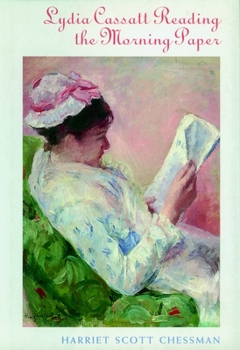Lydia Cassatt Reading the Morning Paper
Select Format
Select Condition 
Book Overview
Harriet Scott Chessman takes us into the world of Mary Cassatt's early Impressionist paintings through Mary's sister Lydia, whom the author sees as Cassatt's most inspiring muse. Chessman hauntingly brings to life Paris in 1880, with its thriving art world. The novel's subtle power rises out of a sustained inquiry into art's relation to the ragged world of desire and mortality. Ill with Bright's disease and conscious of her approaching death, Lydia contemplates her world narrowing. With the rising emotional tension between the loving sisters, between one who sees and one who is seen, Lydia asks moving questions about love and art's capacity to remember. Chessman illuminates Cassatt's brilliant paintings and creates a compelling portrait of the brave and memorable model who inhabits them with such grace. Lydia Cassatt Reading the Morning Paper includes five full-color plates, the entire group of paintings Mary Cassatt made of her sister.
Format:Hardcover
Language:English
ISBN:1583222723
ISBN13:9781583222720
Release Date:November 2001
Publisher:Seven Stories Press
Length:174 Pages
Weight:0.67 lbs.
Dimensions:0.8" x 5.3" x 7.5"
Customer Reviews
5 ratings
Artists and Sisters
Published by Thriftbooks.com User , 22 years ago
This is an extraordinarily moving and beautifully written novel. Chessman takes the reader somewhere new: to the inner life of a famous painter and her dying sister. We see Paris in the 1880s; we meet Degas and the Mary Cassatt; we relive the sudio sessions in which Lydia Cassatt sat as a model for her sister Mary. And beyond all that, we come to confront our own mortality as Lydia poses bravely for her sister, living on in paintings that capture the delicate ties between sisters, between women, among artists and their models. This is a book about life and death, art and love, beauty and transcience. I could not put it down once I started reading it, and I can't stop thinking about it now that I have finished. I recommend it to all.
PITCH PERFECT PROSE CELEBRATES FAMILY, LOVE, AND ART
Published by Thriftbooks.com User , 23 years ago
Art and life. Life and art. The lines pf demarcation aren't' visible in this richly imagined story of the relationship between Impressionist painter Mary Cassatt (1847 - 1926) and her older sister, Lydia, who sometimes served as Cassatt's model. Using five of the artist's paintings as springboards the author offers a moving story of courage and creativity, while she renders a fascinating study of the times in which the women lived. Although suffering painfully, from a terminal illness, Bright's disease, Lydia continues to model for her sister, relentlessly scanning each finished portrait as if it foretold her future. Chessman conceives of Lydia as a study in patience and resignation, imagining that painter Edgar Degas, who often visited the sittings, said to Lydia, "You show me how to live, if only I could do it as you do." In addition to exploring a unique sibling bond "Lydia Cassatt Reading The Morning Paper" suggests aspects of Cassatt's daring life, hints at a liaison with the dynamic Edgar Degas, and presents thumbnail sketches of her interaction with such artists as Renoir and Caillebotte. Lydia, we learn, died in 1882 while Cassatt lived to create for over thirty more years. Rather than a sad reflection on a too short life, Chessman, with pitch-perfect prose, has penned a celebration of family, love, and art. - Gail Cooke
An artful novel about a novel artist
Published by Thriftbooks.com User , 23 years ago
Harriet Chessman has written a beautiful novel about an unusual woman: Mary Cassat, the Impressionist painter who lived in Paris, was a lover of Degas, and a fully emancipated woman during a time when woman were assigned either to the bedroom or the kitchen; a woman who prefered her art and her freedom to marriage and conformity. More than that, it is, in fact, a novel about two women: Mary and her favorite model -- her sister Lydia -- who, while fatally ill with Bright's Disease, posed for many of Mary's paintings.It's such a beautiful and original work on many levels. Each of it's five chapters features a color reproduction of a painting of Lydia, and each painting is a take-off point for the narrator: what she was thinking and feeling, what she was observing about Mary and her friends, and what she felt about the dichotomy of mortality of the flesh and the immortality of the paintings.
A gem of a book
Published by Thriftbooks.com User , 23 years ago
At first glance, I read this book hoping for insight into the life of the painter Mary Cassatt. But the book's truest strength lies in its observations on death and life, and art's role in it. A quiet, understated and beautifully written book. For other books on a similar theme, try Girl in Hyacinth blue by Susan Vreeland (about a painting presumed to be a Vermeer) and Girl with a Pearl Earring by Tracy Chavalier, also about Vermeer.
Best book I've read all year---and I read a lot!
Published by Thriftbooks.com User , 23 years ago
This compassionate, beautifully written tale celebrates life, death, art, poetry, and sisterhood. It lacks the bitterness of Girl with a Pearl Earring, which I didn't care for at all. You will never look at these paintings in the same way again. It also reminded me of the beauty of what my own sister left behind. Many thanks to the author for such a compelling book.





